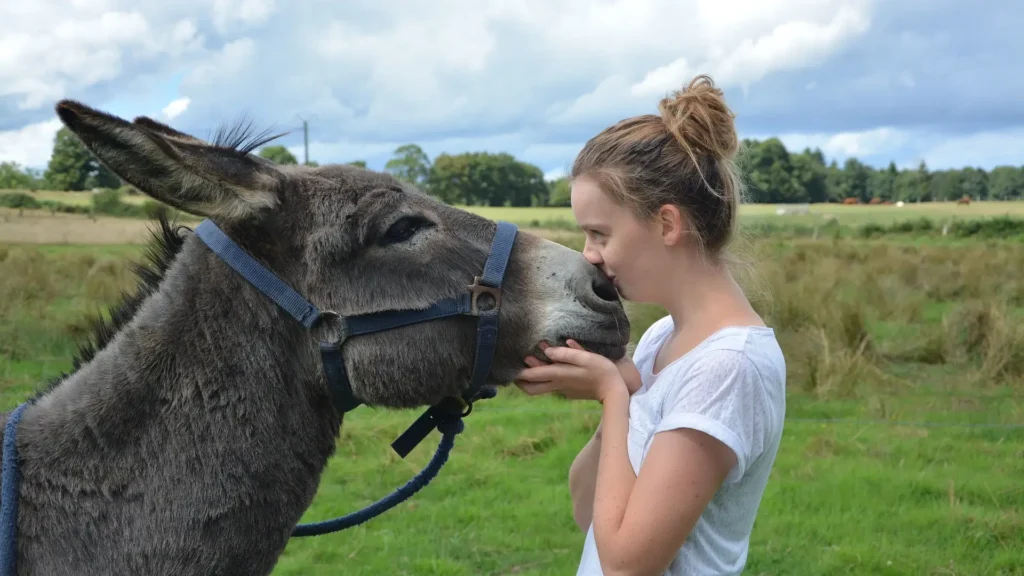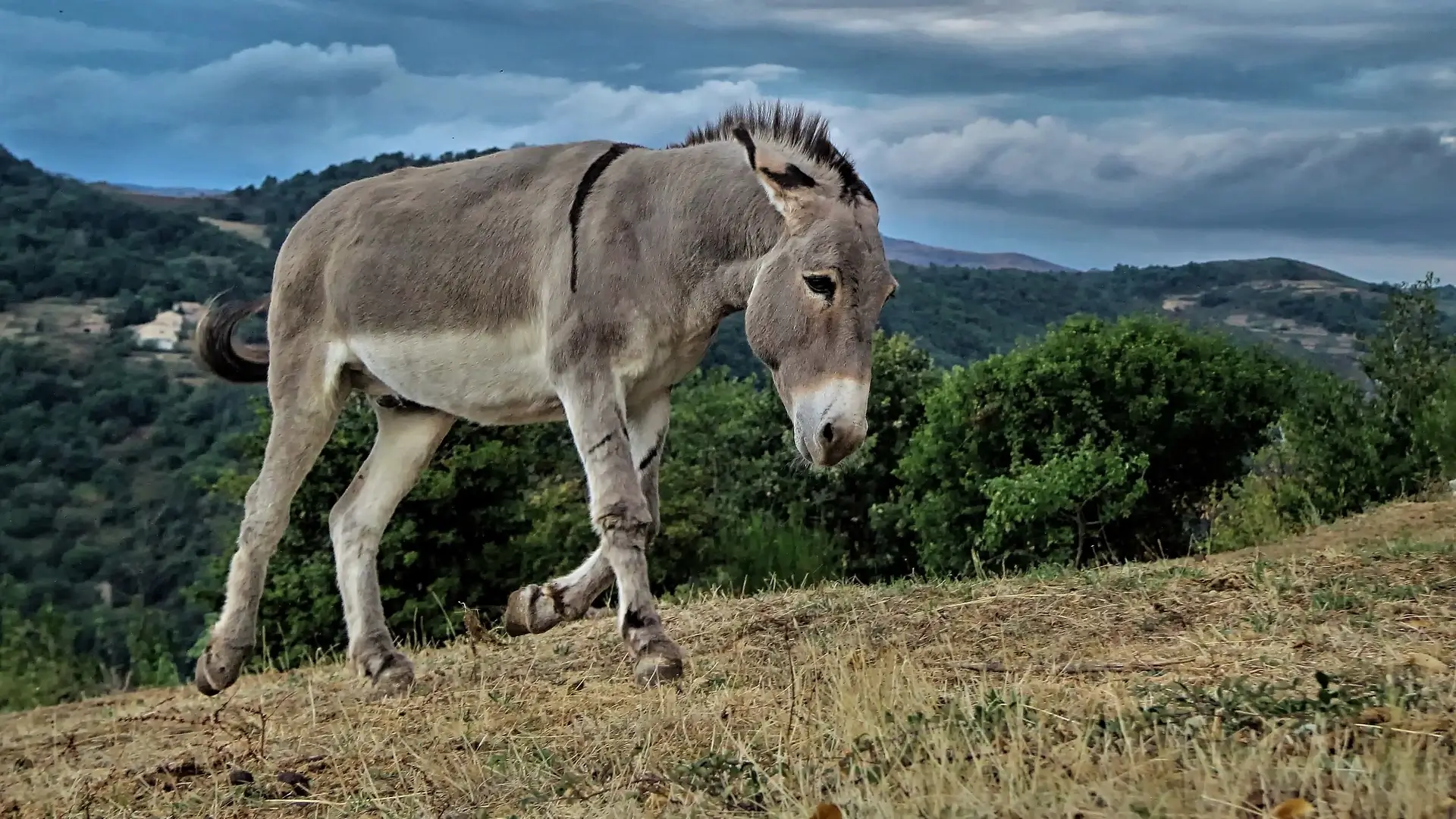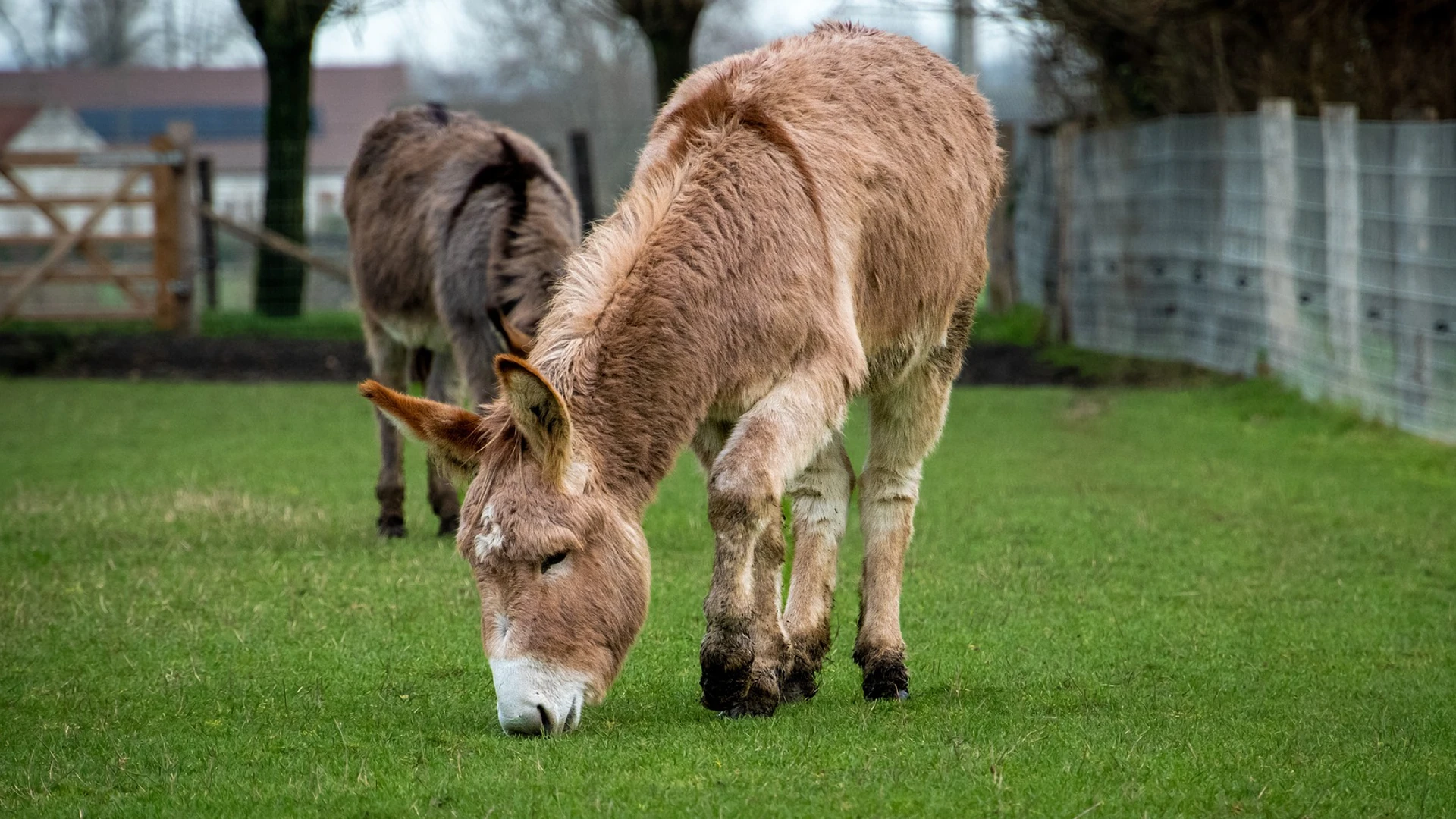Donkeys can’t run as fast as horses and have evolved ways of fighting off a threat rather than fleeing from it. Some people utilize this trait, using donkeys to defend their livestock against predators. Others find the donkey’s seemingly aggressive behavior off-putting, Especially when it involves kicking out violently with his hind legs.
Why do donkeys kick? Donkeys use their powerful back legs to protect their hindquarters and offspring against predators. They also kick to defend their territory and establish dominance over other donkeys or species. In some circumstances, donkeys may also kick in response to pain.
Get a “Kick Out” of Understanding Donkey Behavior
There are five different situations might cause a donkey to become aggressive and kick out.
1. Protecting his territory
Today’s domesticated donkeys are descended from yesterday’s wild ancestors. They lived in a harsh environment where water was limited and vegetation sparse.
Any donkey stallion or jack with sufficient food and water had a much better chance of attracting Jennys. He would, therefore, defend his territory aggressively, using his teeth and hind legs to fend off his aggressor.
The domesticated donkey has not forgotten any of this and will kick out if he feels his territory is breached.
2. Establishing Dominance
Donkeys don’t fight amongst themselves as horses do. Within a natural herd, a stallion takes on the role of leader and defender. He will fight any other stallion that comes into his territory or that tries to entice away any members of his harem.
If a donkey jack perceives you as a threat, he may well try to chase you away with his teeth and even turn tail and kick out at you.
3. Self Defense
There are two reasons a donkey has developed kicking as a form of self-defense.
A donkey can’t see directly behind him. To protect himself against predators tempted by his muscular haunches, the donkey has developed the ability to use his powerful hind legs to deter and injure potential predators.
In the wild, a donkey’s natural predators would include lions, foxes, and wolves, all of which try to sneak up on their prey from behind.
The second reason donkeys kick is that they can’t run as fast as horses. Plus they don’t have the same stamina to outrun their predators. Instead, they use a powerful kick to deter anything pursuing them.
Approaching a donkey from behind replicates the behavior of those natural predators and provokes the same instinctive response.
Defending Their Young
Female donkeys appear to have very little in the way of hierarchy. The only time mares are aggressive towards one another is when they have a newborn foal to protect.
Mares, or Jennys, will usually use every threatening behavior available to them before resorting to kicking. A mare that flattens or twitches her ears, paws the ground, or swishes her tail is trying to communicate her discomfort. If you don’t take note and move out of her space, you could well see a hoof flying in your direction.
Pain, Fear, Or Boredom
Donkeys scared, bored, or experiencing pain may resort to violence to communicate their discomfort.
How To Train A Donkey To Stop Kicking
Before you start training a donkey, make sure there are no physical or medical issues that might be causing his aggressive behavior.
Donkeys are naturally submissive and do everything in their power to avoid confrontation so, a donkey that’s kicking out or acting aggressively could have something wrong with him.
Only once you’re 100% confident your donkey is in good physical and mental health should you try training him to adapt his behavior.
Check out this article for more information about what your donkey’s body language means. This will help you understand what your donkey’s saying more clearly, allowing you to respond appropriately.
The first step in training a donkey not to kick is to use positive reinforcement techniques to teach him to move his hindquarters away from you when asked. This is the first exercise we’ll look at. Desensitizing your donkey to the touch will also help him understand that, when handling him, you won’t hurt him or try to dominate him.
Don’t be aggressive with your donkey. Remember, he’s only performing behavior that’s natural to him. You just need to teach him an alternative way of coping with the threat he perceives.
Training Good Donkey Behavior
This exercise aims to get your donkey to engage the thinking side of his brain, rather than simply reacting instinctively. You also going to get him to respond differently to pressure.
Instead of trying to attack the source of pressure, you’re going to teach your donkey that’s is more comfortable to move away from it.
While this exercise can be done with just a lead rope or lunge line and your hand, using a wand or similar training tool makes it safer. In the past, I’ve tied an old glove onto a mop handle and used that to replicate my hand. This enables me to perform the exercise safely from outside the danger zone.
Train Your Donkey to Move on Command
- Start by standing in front of your donkey. Using either your hand or training tool, put gentle pressure on his chest while simultaneously applying the same amount of pressure to the lead rope.
- Your donkey should respond to the pressure by moving away from it.
- The moment he starts to move backward, even if it’s only a small movement, release the pressure immediately and reward him with a treat or a scratch.
- Repeat the exercise, increasing the number of steps he takes backward as you do so.
- You can also reverse the exercise and ask him to move back towards you by pulling gently on the lead rope.
- Be patient and stay neutral throughout the exercise. Like horses, donkeys are very sensitive to your body language and emotions and likely to mirror any aggression or frustration he picks up on in you.
- Once your donkey is moving backward and forwards freely and willingly, it’s time to move onto the hindquarters.
- Standing level with your donkey’s hip and close to his flank, swing the loose end of your lead rope in a gentle arc, aiming it towards to hindquarters.
- Your donkey should move away from the lead rope, shifting his hindquarters in the opposite direction.
- If he moves towards the lead rope or attempts to kick it, simply continue swinging. Ignore his negative response and focus on achieving your original goal.
- If your donkey refuses to move, increase the pressure. You can do this either by allowing the lead rope to touch his hindquarters gently or by using your hand to push gently on his hip.
- Remember, a donkey can kick to the side and backward, so make sure you stay close to his side and out of danger.
- As soon as your donkey moves away from the pressure, drop the lead rope and reward him.
If you can get your donkey to move his hindquarters away from you and back up when asked, you’re establishing yourself as a passive leader. This helps to remove all aggression from the situation. When his hindquarters are moving, they’re also disengaged, making it harder for your donkey to kick out.
How To Desensitize Your Donkey To Stop Him From Kicking
This exercise aims to help your donkey accept the human touch rather than fear it. Again, you can perform this exercise using just your hand or, if you feel uncomfortable being in close proximity with him, a wand or similar training tool.
- Start by standing in front of your donkey.
- If you’re using a training tool, show it to your donkey and let him familiarize himself with it. This familiarization process can include sniffing, biting, and licking the object.
- When you’re ready, gently touch your donkey with your hand or training tool, starting at the shoulder.
- Move slowly up his neck towards his ears and then down along his front legs.
- Watch your donkey for any signs of discomfort or aggression, including shaking his head, shifting his weight, or pinning his ears back.
- If your donkey looks uncomfortable, take a step back and start touching him at the shoulder again.
- Repeat these steps until your donkey is relaxed and comfortable with being touched everywhere from the shoulder to the ears, and down to the front hooves.
- You’re now ready to move along the body and start touching him on the withers, flanks, and back.
- Again, proceed slowly and keep the pressure firm but gentle. You don’t want to prod or poke your donkey, but you don’t want to tickle him either!
- When you get the hindquarters, make sure you’re standing close to the donkey and out of harm’s way.
- If you’re nervous about being kicked, use a wand or mop or anything that allows you to increase your reach.
- Slowly move the wand over his rump and down towards his hocks.
- If your donkey kicks out, move the wand back to a place your donkey finds comfortable and repeat the exercise.
- Keep repeating the exercise until your donkey accepts the touch on his hindlegs without kicking out at it.
If your donkey displays any unwanted behavior, be it kicking, stomping, or flattening his ears, return to the first exercise. This will show your donkey that he’ll have to work harder every time he kicks out.
Donkeys are intelligent animals and will quickly learn that that the path of least resistance – and least work – is one where they stand quietly instead of kicking out.
You’ve now taught your donkey that human touch is nothing to be afraid of and that kicking results in work, whereas acceptance results in treats and scratches. This is known as positive reinforcement training.
The Best Way To Discipline a Donkey
Donkeys don’t respond well to being bullied, nor are they particularly responsive to negative reinforcement. Try and beat a donkey into submission, and he’ll just become more stubborn and potentially even more aggressive.
Positive reinforcement is a much more effective approach and involves rewarding your donkey when he performs the desired behavior rather than punishing him for failing. Donkeys have a reputation for being stubborn because, unlike horses, they don’t rely on flight as a means to resolve conflict. This makes them more likely to challenge a person than back away.
To effectively train your donkey not to kick, you must remain calm and consistent throughout the exercises. In most instances, aggression is a reaction to a perceived threat. If your donkey trusts and respects you, this behavior will naturally disappear.
Stallions are often more aggressive than mares because they instinctively want to protect the herd. If this is the case, you might want to consider gelding your donkey before you start training. This will often help him calm down and eliminate some of his instinctive aggression.
A donkey that’s kicking in boredom or frustration, on the other hand, will respond quickly to positive reinforcement training. It will stimulate him mentally and help alleviate the boredom that caused the aggressive behavior initially.
If you’re not confident about handling your donkey in this way yourself, ask a professional or more experienced donkey handler to help you out.
Conclusion
While it’s natural for donkeys to kick in certain situations, such behavior makes handling the animal potentially dangerous. Donkeys don’t respond well to punishment. Using positive reinforcement techniques is the most effective way of stopping your donkey from kicking. Not only will it teach him good ground manners, but it will also help you and your donkey bond.
Once you’ve established a relationship based on mutual trust and respect, your donkey won’t want to kick you anymore. Don’t forget – donkeys are naturally submissive animals that only kick when they feel threatened and need to defend themselves or protect their herd.
My Favorite Equine Resources For Horses and Donkeys
This list contains affiliate products. Affiliate products do not cost more but helps to support BestFarmAnimals and our goal to provide farm animal owners with accurate and helpful information.
Squeaky Chicken Toy is hilarious to watch and the horses love it! It’s not super tough so keep it away from dogs.
Dewormer with Ivermectin: I use this for my horses and my goats. Duvet makes a great dewormer. I switch between the Ivermectin one and one like this one so the worms don’t get immune to it.
Manna Pro Apple Flavored Nuggets are a delicious smelling treat that my horses go crazy over.
Equinity Amino Acid Supplement for Horses makes a big difference for any horse that’s struggling with arthritis, hoof issues, or just generally. It’s great for older horses who can’t absorb all the nutrients in their food as well!
Manna Pro Weight Accelerator helps older horses gain weight and stay healthier! This was especially helpful when one of my older horses lost weight over the winter and helped her regain her weight over the summer!
Farnam Fly Control goes on the horse or donkey and will keep the flies off your sweet pet. It makes horses way more comfortable and will keep sores from getting infected as well.
Wound Kote protects sores and wounds. It acts as an antiseptic and helps wounds heal faster. It works on both my horses and goats.



